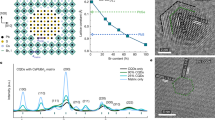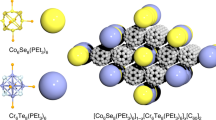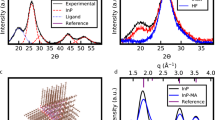Abstract
Size and shape tunability and low-cost solution processability make colloidal lead chalcogenide quantum dots (QDs) an emerging class of building blocks for innovative photovoltaic, thermoelectric and optoelectronic devices. Lead chalcogenide QDs are known to crystallize in the rock-salt structure, although with very different atomic order and stoichiometry in the core and surface regions; however, there exists no convincing prior identification of how extreme downsizing and surface-induced ligand effects influence structural distortion. Using forefront X-ray scattering techniques and density functional theory calculations, here we have identified that, at sizes below 8 nm, PbS and PbSe QDs undergo a lattice distortion with displacement of the Pb sublattice, driven by ligand-induced tensile strain. The resulting permanent electric dipoles may have implications on the oriented attachment of these QDs. Evidence is found for a Pb-deficient core and, in the as-synthesized QDs, for a rhombic dodecahedral shape with nonpolar {110} facets. On varying the nature of the surface ligands, differences in lattice strains are found.
This is a preview of subscription content, access via your institution
Access options
Subscribe to this journal
Receive 12 print issues and online access
$259.00 per year
only $21.58 per issue
Buy this article
- Purchase on Springer Link
- Instant access to full article PDF
Prices may be subject to local taxes which are calculated during checkout






Similar content being viewed by others
References
Kovalenko, M. V. et al. Prospects of nanoscience with nanocrystals. ACS Nano 9, 1012–1057 (2015).
Kovalenko, M. V., Scheele, M. & Talapin, D. V. Colloidal nanocrystals with molecular metal chalcogenide surface ligands. Science 324, 1417–1420 (2009).
Ibañez, M. et al. Electron doping in bottom-up engineered thermoelectric nanomaterials through HCl-mediated ligand displacement. J. Am. Chem. Soc. 137, 4046–4049 (2015).
Zhang, J., Gao, J., Miller, E. M., Luther, J. M. & Beard, M. C. High photocurrent PbSe solar cells with thin active layers. ACS Nano 8, 614–622 (2014).
Lan, X., Masala, S. & Sargent, E. H. Charge-extraction strategies for colloidal quantum dot photovoltaics. Nature Mater. 13, 233–240 (2014).
Zagorac, D., Doll, K., Schön, J. C. & Jansen, M. Sterically active electron pairs in lead sulfide? An investigation of the electronic and vibrational properties of PbS in the transition region between the rock salt and the α-GeTe-type modifications. Chem. Eur. J. 108, 10929–10936 (2012).
Bozin, E. S. et al. Entropically stabilized local dipole formation in lead chalcogenides. Science 330, 1660–1663 (2010).
Kastbjerg, S. et al. Direct evidence of cation disorder in thermoelectric lead chalcogenides PbTe and PbS. Adv. Funct. Mater. 23, 5477–5483 (2013).
Moreels, I. et al. Size-tunable, bright, and stable PbS quantum dots: a surface chemistry study. ACS Nano 5, 2004–2012 (2011).
Moreels, I., Fritzinger, B., Martins, J. C. & Hens, Z. Surface chemistry of colloidal PbSe nanocrystals. J. Am. Chem. Soc. 130, 1581–1586 (2008).
Zherebetsky, D. et al. Hydroxylation of the surface of PbS nanocrystals passivated with oleic acid. Science 344, 1380–1383 (2014).
Anderson, N. C., Hendricks, M. P., Choi, J. J. & Owen, J. S. Ligand exchange and the stoichiometry of metal chalcogenide nanocrystals: spectroscopic observation of facile metal-carboxylate displacement and binding. J. Am. Chem. Soc. 135, 18536–18548 (2013).
Kim, D., Kim, D.-H., Lee, J.-H. & Grossman, J. C. Impact of stoichiometry on the electronic structure of PbS quantum dots. Phys. Rev. Lett. 110, 196802 (2013).
Cervellino, A., Frison, R., Bertolotti, F. & Guagliardi, A. DEBUSSY 2.0—the new release of a Debye user system for nanocrystalline and/or disordered materials. J. Appl. Crystallogr. 48, 2026–2032 (2015).
Chattopadhyay, T., Boucherlet, J. X. & von Schnering, H. G. Neutron diffraction study on the structural phase transition in GeTe. J. Phys. C 20, 1431–1440 (1987).
Berger, R. et al. Surface stress in the self-assembly of alkanethiols on gold. Science 276, 2021–2024 (1997).
Cho, K. S., Talapin, D. V., Gaschler, W. & Murray, C. B. Designing PbSe nanowires and nanorings through oriented attachment of nanoparticles. J. Am. Chem. Soc. 127, 7140–7147 (2005).
Klokkenburg, M. et al. Dipolar structures in colloidal dispersions of PbSe and CdSe quantum dots. Nano Lett. 7, 2931–2936 (2007).
Lee, S. M., Jun, Y. W., Cho, S. N. & Cheon, J. Single-crystalline star-shaped nanocrystals and their evolution: programming the geometry of nano-building blocks. J. Am. Chem. Soc. 124, 11244–11245 (2002).
Dong, L., Chu, Y., Zuo, Y. & Zhang, W. Two-minute synthesis of PbS nanocubes with high yield and good dispersibility at room temperature. Nanotechnology 20, 125301 (2009).
Huang, W.-C., Lyu, L.-M., Yang, Y.-C. & Huang, M. H. Synthesis of Cu2O nanocrystals from cubic to rhombic dodecahedral structures and their comparative photocatalytic activity. J. Am. Chem. Soc. 134, 1261–1267 (2012).
Simon, P. et al. Interconnection of nanoparticles within 2D superlattices of PbS/oleic acid thin films. Adv. Mater. 26, 3042–3049 (2014).
Boneschanscher, M. P. et al. Long-range orientation and atomic attachment of nanocrystals in 2D honeycomb superlattices. Science 344, 1377–1380 (2014).
Matthew, K., Sundararaman, R., Letchworth-Weaver, K., Arias, T. A. & Hennig, R. G. Implicit solvation model for density-functional study of nanocrystal surfaces and reaction pathways. J. Chem. Phys. 140, 084106 (2014).
Schapotschnikow, P., van Huis, M. A., Zandbergen, H. W., Vanmaekelberh, D. & Vlugt, T. J. H. Morphological transformations and fusion of PbSe nanocrystals studied using atomistic simulations. Nano Lett. 10, 3966–3971 (2010).
Schliehe, C. et al. Ultrathin PbS sheets by two-dimensional oriented attachment. Science 329, 550–2936 (2010).
Dirin, N. D. et al. Lead halide perovskites and other metal halide complexes as inorganic capping ligands for colloidal nanocrystals. J. Am. Chem. Soc. 136, 6550–6553 (2014).
Ning, Z. et al. Quantum-dot-in-perovskite solids. Nature 523, 324–328 (2015).
Li, D. et al. Direction-specific interaction control crystal growth by oriented attachment. Science 336, 1014–1018 (2012).
van Huis, M. A., Kunneman, L. T., Overgaag, K., Zandbergen, H. W. & Vanmaekelberh, D. Low-temperature nanocrystal unification through rotations and relaxations probed by in situ transmission electron microscopy. Nano Lett. 10, 3966–3971 (2010).
Casavola, M. et al. Anisotropic cation exchange in PbSe/CdSe core/shell nanocrystals of different geometry. Chem. Mater. 8, 3959–3963 (2008).
Wuttig, M. et al. The role of vacancies and local distortions in the design of new phase-change materials. Nature Mater. 6, 122–128 (2007).
Cervellino, A. et al. Diffuse scattering from the lead-based relaxor ferroelectric PbMg1/3Ta2/3O3 . J. Appl. Crystallogr. 44, 603–609 (2011).
VandeVondele, J. et al. Quickstep: fast and accurate density functional calculations using a mixed Gaussian and plane waves approach. Comput. Phys. Commun. 167, 103–128 (2005).
Acknowledgements
F.B. acknowledges University of Insubria for Junior Fellowship Grant 2013, M.V.K. acknowledges the European Union for financial support via FP7 ERC Starting Grant 2012 (Project NANOSOLID, GA No. 306733), D.N.D. thanks the European Union for Marie Curie Fellowship (PIIF-GA-2012-330524) and M.I. thanks AGAUR for her Beatriu i Pinós post-doctoral grant (2013 BP-A 00344). Synchrotron XRPD data were collected at the X04SA-MS Beamline of the Swiss Light Source. M. Döbeli is gratefully acknowledged for taking RBS spectra. Electron microscopy was performed at the Scientific Center for Optical and Electron Microscopy (ScopeM) at ETH Zürich. Computations were performed using the BlueGene/Q supercomputer at the SciNet HPC Consortium provided through the Southern Ontario Smart Computing Innovation Platform (SOSCIP). We thank N. Stadie and J. Mason for reading the manuscript.
Author information
Authors and Affiliations
Contributions
A.G., N.M. and M.V.K. formulated the project. D.N.D. and M.I. synthesized the compounds and performed the optical properties characterization. A.C., F.B., R.F., A.G. and N.M. collected and analysed the X-ray total scattering data. F.K. collected and analysed the electron microscopy images. O.V. and E.H.S. performed DFT calculations. A.G. and N.M. wrote the manuscript, with the contribution of all authors.
Corresponding authors
Ethics declarations
Competing interests
The authors declare no competing financial interests.
Supplementary information
Supplementary Information
Supplementary Information (PDF 21618 kb)
Rights and permissions
About this article
Cite this article
Bertolotti, F., Dirin, D., Ibáñez, M. et al. Crystal symmetry breaking and vacancies in colloidal lead chalcogenide quantum dots. Nature Mater 15, 987–994 (2016). https://doi.org/10.1038/nmat4661
Received:
Accepted:
Published:
Issue Date:
DOI: https://doi.org/10.1038/nmat4661
This article is cited by
-
A deep learning approach for quantum dots sizing from wide-angle X-ray scattering data
npj Computational Materials (2024)
-
Small, solubilized platinum nanocrystals consist of an ordered core surrounded by mobile surface atoms
Communications Chemistry (2024)
-
Enabling metallic behaviour in two-dimensional superlattice of semiconductor colloidal quantum dots
Nature Communications (2023)
-
Electrochemical modulation of trap states in PbS QDs and their electrical characterization
Journal of the Korean Physical Society (2022)
-
Observation of ordered organic capping ligands on semiconducting quantum dots via powder X-ray diffraction
Nature Communications (2021)



